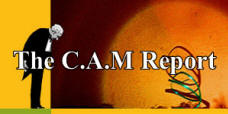|
Visit my blog:

Complementary and Alternative
Medicine: Fair and Balanced |
| |
Seven
benefits and risks associated with genetic manipulation
By John Russo/Vicus.com
|
|
VICUS.COM (14 March 2000) -- The
practice of mixing genes to improve crop quality and yield is not new.
Prior to the development of recombinant DNA technology, success in this field was achieved with very
little understanding of the biochemical mechanisms that determined the
selected traits.
Every time a cross was made, tens of thousands of genes were mixed
and reorganized, largely at random. Breeders then kept the preferred
offspring, while discarding the descendents that lacked desirable
traits or exhibited undesirable properties.
The advent of recombinant DNA technology for genetic manipulation
provides biologists with a more powerful and selective tool. It
extends the range of biological materials from which genes can be
accessed. It also permits scientists to be very specific in altering
the genetic makeup of new crop varieties. If done correctly, the
promise of greater crop yields and an end to world hunger is possible.
Done, incorrectly, it could be the incarnation of your worst science
fiction movie.
Seven desirable outcomes from altering the genetic makeup of new
crop varieties
- Altered plant fats and oils to improve health
- Environmentally benign herbicides
- Longer shelf life of foods at full ripeness
- Methionine- and lysine-enhanced grain and legume proteins
- Plant foods that deliver immunizing antigens
- Reduced world hunger
- Resistance to pests, and diseases
|
Health Risk
|
Concerns
|
Scientific
Support?
|
|
Toxicity
|
Genetic
manipulation could enhance natural plant toxins by switching
on a gene with toxic effects.
|
No
scientifically valid study.
|
|
Allergies
|
People with
allergies could be exposed to proteins they react to without
knowing it (eg, if a peanut, wheat, or shellfish gene, was
transplanted into corn.
|
A few years
ago, a Brazil nut gene spliced into soybeans induced
allergies in people sensitive to the nuts.
|
|
Bad nutrition
|
Foreign genes
might alter the nutritional value of food in unpredictable
ways.
|
The Journal
of Medicinal Food reported that concentrations of phytoestrogens (thought to protect against heart disease and
perhaps cancer) were lower in genetically
modified soybeans vs traditional strains.
|
|
Antibiotic
resistance
|
When a foreign
gene is spliced into a plant or microbe, a marker gene helps
determine if the first gene was successfully taken up. Most
markers code for resistance to antibiotics and might be
passed on to disease-causing microbes in the intestines of
people who eat altered food. This could contribute to the
public-health problem of antibiotic resistance.
|
No
scientifically valid study.
|
|
Environmental
risks
|
|
|
Losing a safe
natural pesticide
|
Among
genetically modified products are crops with a gene from the
soil bacterium Bacillus thuringiensis (Bt)
that produces a protein toxic to insects. Overexposure to Bt
will help insects become resistant.
|
No
scientifically valid study.
|
|
Harm to
innocents
|
In lab studies,
monarch butterfly caterpillars that ate milkweed dusted with
pollen from Bt corn died or developed abnormally.
Ecologists worry that other "nontarget species"
could be harmed.
|
Letter to the
editor, Nature.
|
|
Superweeds
|
Insect
resistance and herbicide toleranceómay be passed on to
wild plants, particularly weeds an then an advantage over
competing plant species
|
One report of
herbicide-tolerant canola cross- pollinated with a related
weed species, producing a herbicide-tolerant descendant.
|
John
Russo, Jr. PharmD, is senior vice president of medical
communications at Vicus.com. He is a pharmacist and medical writer
with more than 20 years of experience in medical education.

|
References:
Day
PR. Genetic
modification of proteins in food. Crit
Rev Food Sci Nutr.
1996; 36 Suppl:S49-67. Losey JE; Rayor LS; Carter ME. Transgenic
pollen harms monarch larvae [letter]. Nature,
1999; 399(6733):214.
Tangley
L. How safe is genetically modified food? (transgenic foods could
trigger allergies, antibiotic resistance, and other health problems). U.S.
News & World Report, July
26, 1999 v127 i4 p40.
|
|